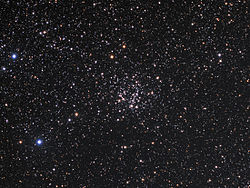NGC 663

|
|
| NGC 663 | |
| AladinLite | |
| Constellation | Cassiopeia |
|
Position equinox : J2000.0 |
|
|---|---|
| Right ascension | 01 h 46 m 16.0 s |
| declination | + 61 ° 13 ′ 05 ″ |
| Appearance
|
|
| classification | III 2 m |
| Brightness (visual) | +7.1 mag |
| Angular expansion | 15 ' |
| Number of stars | about 80 |
| Brightest star | +8.4 mag |
| Physical data
|
|
| Affiliation |
Milky Way , Cas OB8 |
| distance | approx. 6400 ly (1952 pc ) |
| history | |
| Discovered by | William Herschel |
| Discovery time | November 3, 1787 |
| Catalog names | |
| NGC 663 • C 0142 + 610 • OCl 333 • Mel 11 • Cr 20 • Lund 55 • GC 392 • H VII 31 • | |
NGC 663 is an open star cluster in the constellation Cassiopeia . NGC 663 is 15 'in diameter and has an apparent magnitude of 7.1 mag. NGC 663 is a relatively young star cluster and contains numerous Be stars. The distance to the sun is about 6500 light years, its age is estimated to be about 20 million years.
NGC 663 is part of the OB association Cassiopeia OB8, which includes NGC 654 and Messier 103 , among others . NGC 663 is considered to be the most massive star cluster and core of Cassiopeia OB8. The double star Struve 152 is a member of the star cluster.
NGC 663 was discovered on November 3, 1787 by the German-British astronomer Friedrich Wilhelm Herschel .
Web links
- Spektrum.de : Amateur recordings [1] [2] [3]
Individual evidence
